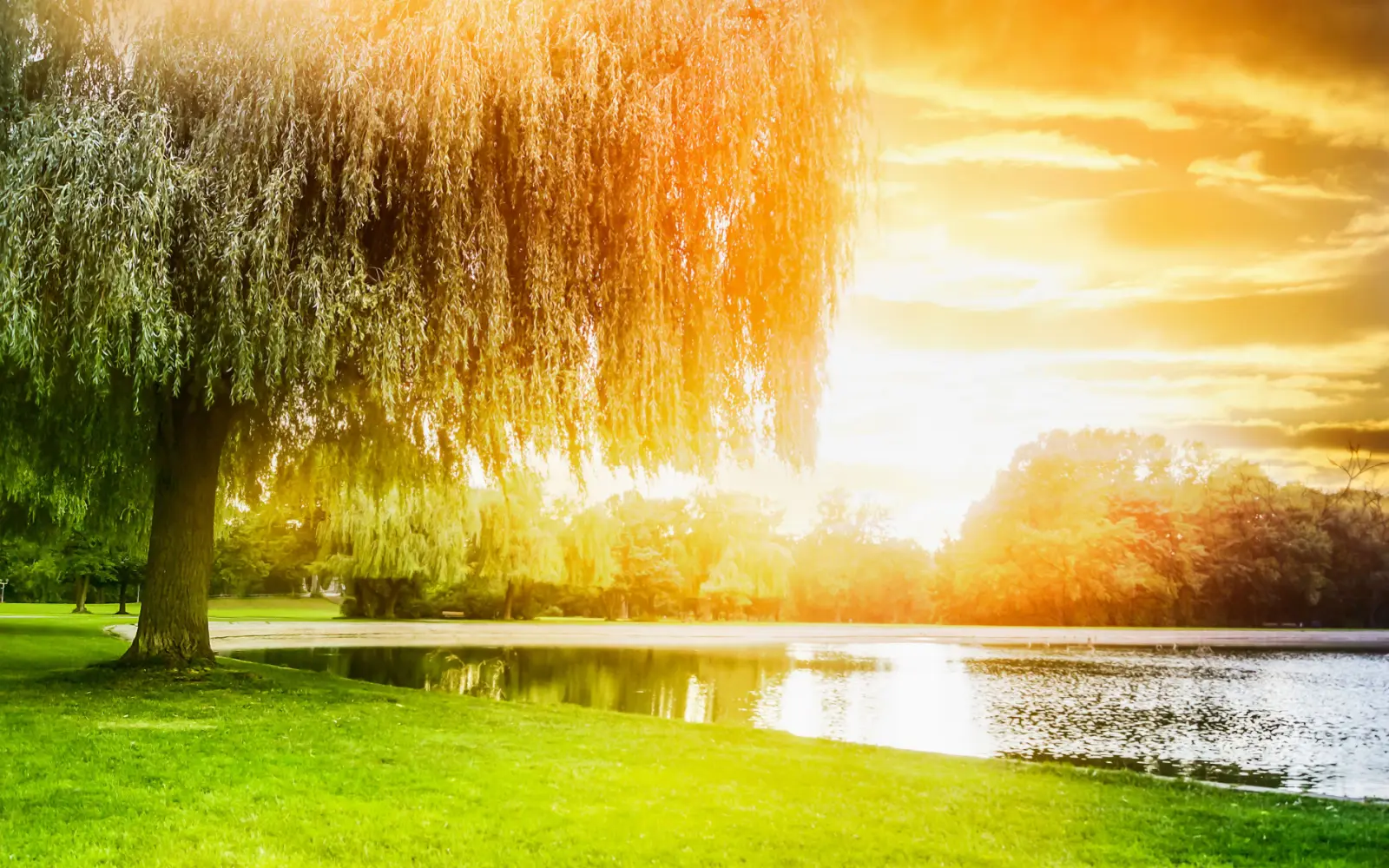Willow trees are renowned for their health benefits, from treating osteoarthritis and lower back pains to combating inflammatory issues like tendinitis and bursitis.
However, these trees have more than 400 species, which can be confusing if you want to add one to your backyard collection. But don’t get overwhelmed; instead, read about the 8 most common types of willow trees below.
Popular Types of Willow Trees: A Summary
- Bebb willow
- Weeping willow
- Corkscrew willow
- Dappled willow
- Purple Osier willow
- Scouler’s willow
- Almond willow
- Crack willow
There are two main varieties of willow trees: sallows and osiers. Sallows have broad leaves, while osiers have narrow leaves and are shrubby.
This article discusses the properties of prominent types of willow trees and explains these trees’ growing processes.
The 8 Most Popular Types of Willow Trees
Below are the willow trees you’re likely to encounter.
1. Bebb Willow
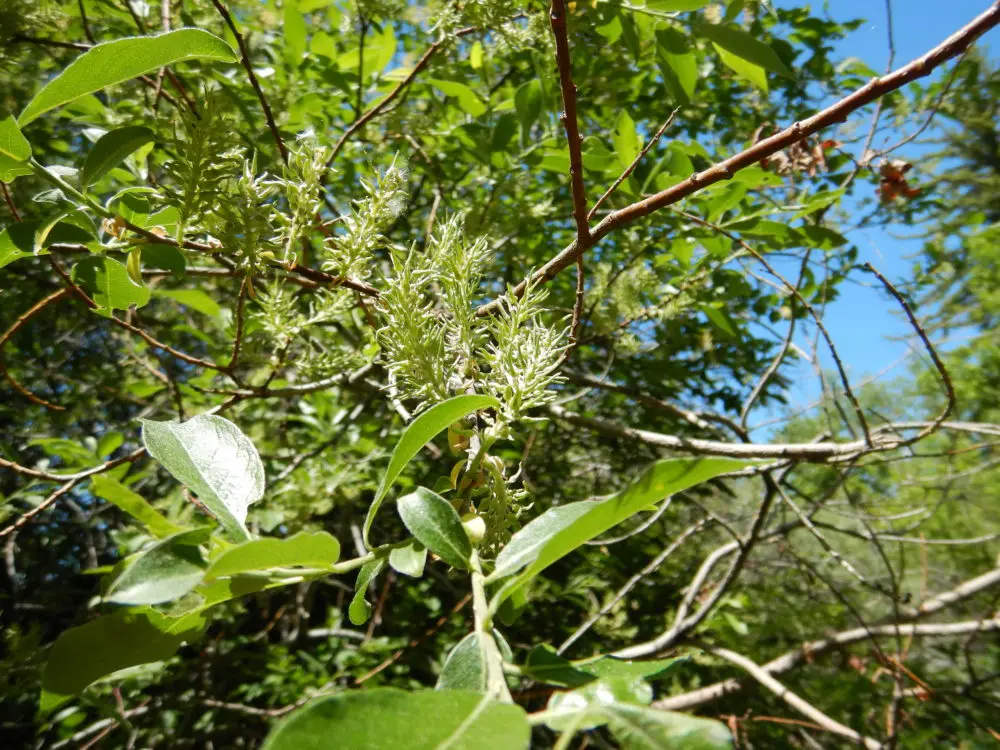
Matt Lavin/Flickr
This species is also known as gray willow, beaked willow, diamond willow, and long-beaked willow. The leaves on Bebb willows have a dull blue-green color and a smooth texture.
They grow up to twelve centimeters long, have an ovate shape, and are pointed. On the other hand, Bebb stems can grow to thirty feet, equivalent to nine meters.
Bebb willow trees are native to Canada and several US states, like Yukon South, Alaska, New England, Arizona, and California. These trees can grow in full sun or in shaded regions.
Although Bebb willows are drought-intolerant, insects easily destroy them. As a result, they have a short lifespan and are unsuitable for landscaping. That said, Bebb willows are ideal for woodwork and protecting riverbanks.
2. Weeping Willow
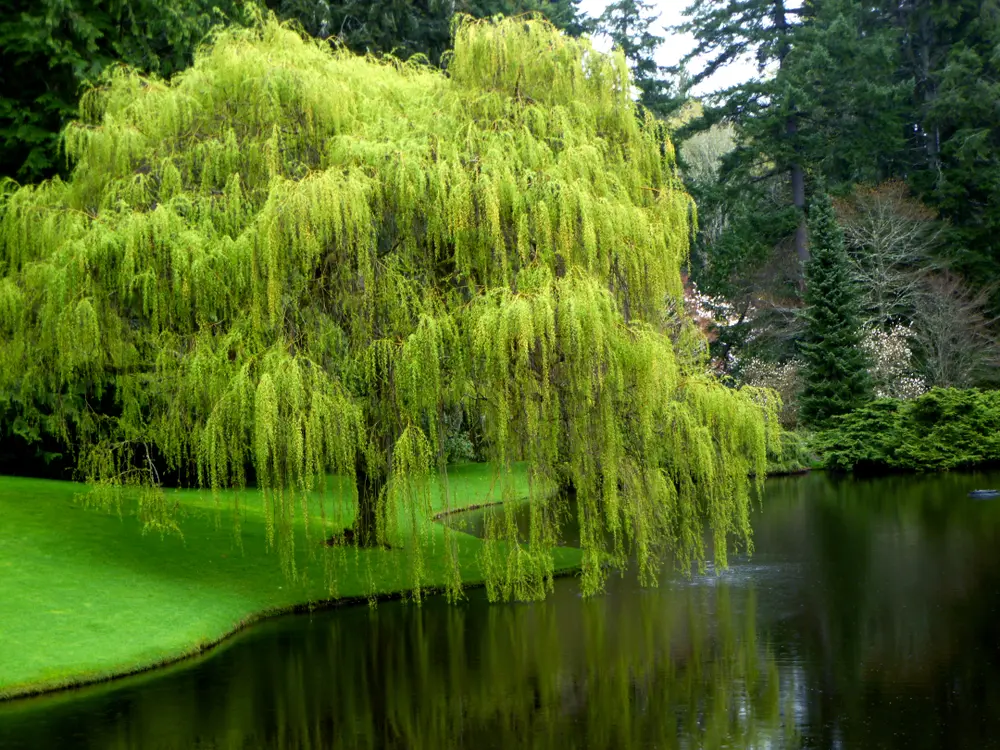
Lee Hadan/Shutterstock
Weeping willows are mainly used for landscaping. You could find them around large yards or on lake and pond edges. These trees’ appearance is pretty dramatic; you can’t miss them.
Their long, cascading, and roopy branches form a circular canopy and flow to the ground, touching it lightly. The barks are gray and rough. These trees’ leaves have two colors: light green at the top and somewhat silverish on the undersides.
Their lengths range between four and fifteen centimeters, while they can grow up to two centimeters thick. The leaves have serrated margins. Weeping willows are relatively tall, growing up to 25 meters high.
They bloom beautiful yellow flowers known as catkins during the spring or winter. These trees grow in 6 to 9 USDA growing zones and are native to Northern China. Weeping willows require full sun exposure to flourish.
3. Corkscrew Willow
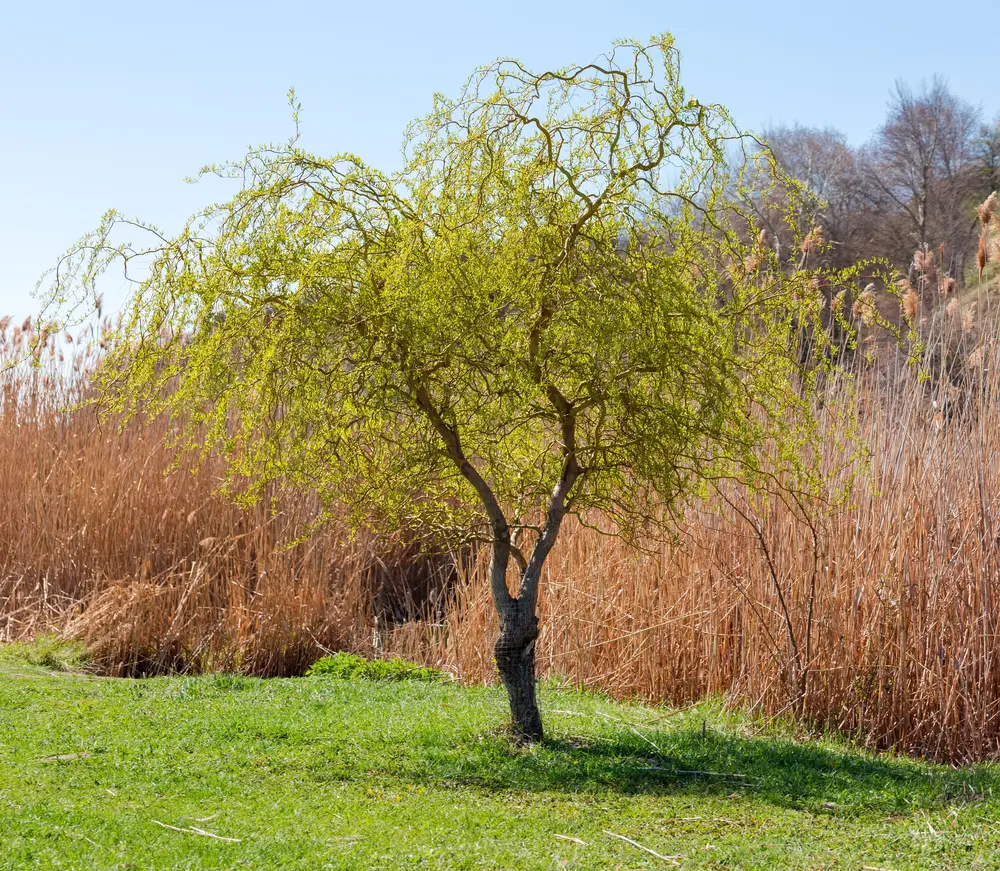
anmbph/Shutterstock
Corkscrew willows are another easily identifiable willow species. These trees have long, cascading, and twisted branches when they mature.
These branches are tender and green when young. Corkscrew willows are fast-growing but susceptible to insect infestation.
This willow species is indigenous to northeastern China and grows in 4 to 9 USDA growing zones. Corkscrew leaves are twisted and oval-shaped, with serrated edges. The top side of the leaves is light green, while the lower side is off-white or silverish.
These trees have smooth gray barks, which may develop lenticels as they mature. These trees develop large and fluffy yellow flowers during early spring. One-inch cluster fruits also appear during this period.
These fruits are light brown and have tiny fuzzy seeds inside. Corkscrew willows grow up to fifty feet tall and flourish in full sun and shady locations.
Thanks to their beauty, corkscrew willows are used as bonsai or incorporated into flower arrangements.
4. Dappled Willow
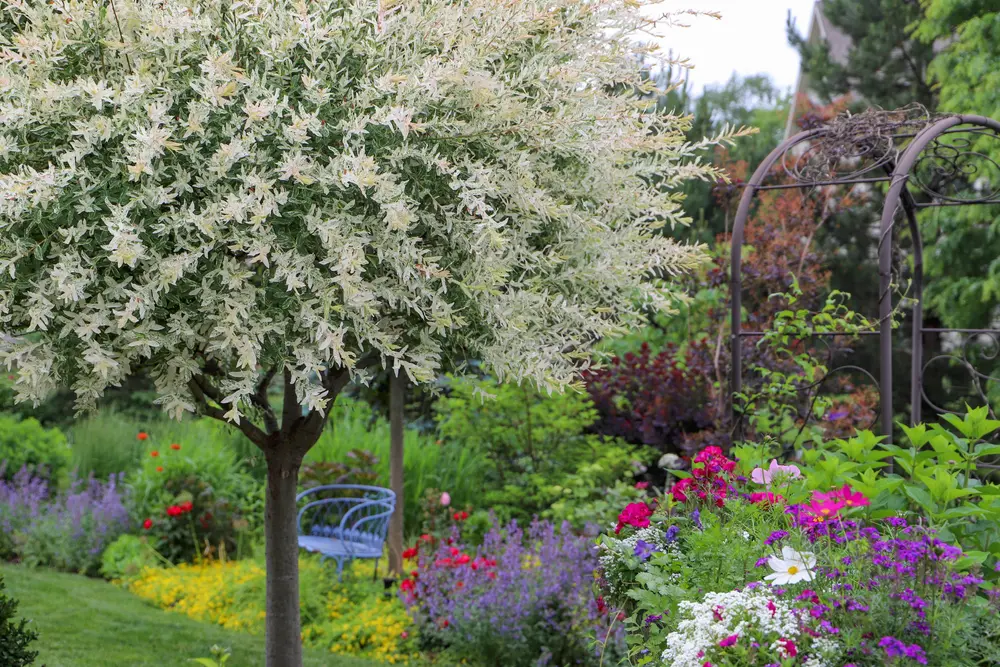
Molly Shannon/Shutterstock
The dappled willow is one of the shrubby willow species. This tree produces variegated leaves in three colors: green, white, and pink. The leaves first appear in a pink shade, which turns green and eventually fades to white.
The dappled willow is a beautiful tree during the winter, as its branches turn red after shedding their leaves. This tree’s foliage never surpasses ten centimeters in length and two centimeters in thickness.
Unlike other willow trees, whose leaves grow alternatively, dappled leaves grow in opposite pairs. Although dappled willows grow at a fast rate of two feet per year, these trees can only grow up to ten feet high.
Dappled willows have lovely round shapes, which work perfectly as a privacy hedge if you plant several in a row.
These trees are indigenous to Korea and Japan and mainly grow in marshes and along riverbanks. These trees are found in 4 to 9 USDA growing zones and thrive in full sun and partly shady areas.
5. Purple Osier Willow
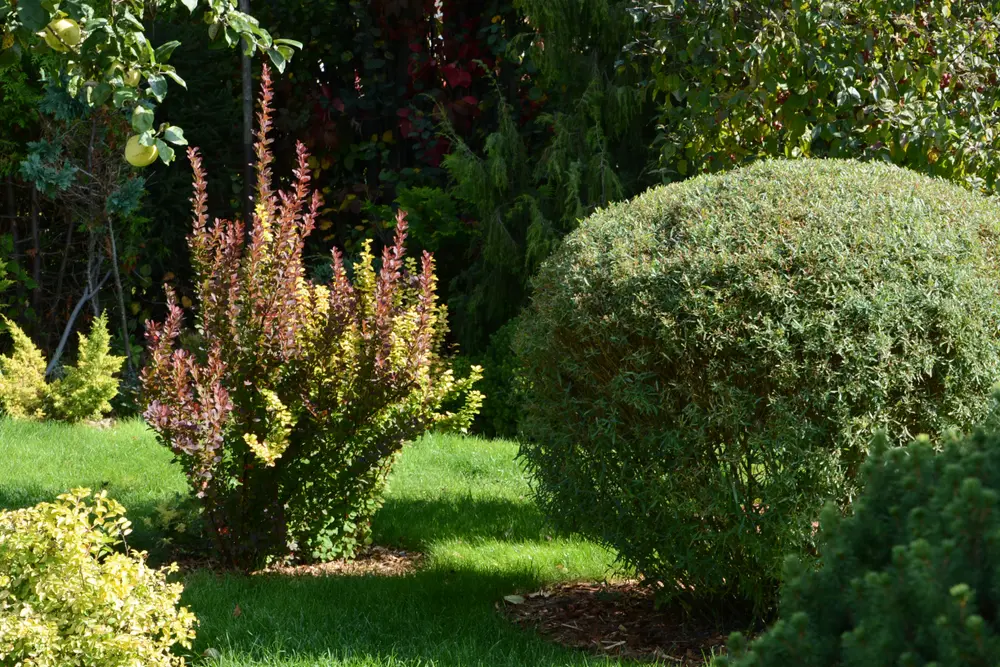
Vladimir Shulikovskiy/Shutterstock
Purple osier willows are the most conspicuous willow species. These trees have purple stems with green and blue leaves. The leaves are elongated, have a lanceolate shape, are usually eight centimeters long, and don’t exceed a width of two centimeters.
Osier’s leaves are dark green on the top side and have a dull grayish-green shade on the bottom. The purple osier also has peculiar flowers, smaller than other willow catkins, and purple or sometimes red instead of yellow and white.
These flowers are mostly about five centimeters long and appear during spring. To maintain the purple osier’s decorative shape, you’ll have to trim it every three to five years. Use this willow tree to combat erosion along riverbanks and around lakes.
You can also plant it as a fence, enhancing your home’s outlook with its vibrant flowers. The purple osier willow is indigenous to western Asia and Europe. It does exceptionally well in regions that receive full sun. It thrives in 4 to 9 USDA growing zones.
6. Scouler’s Willow
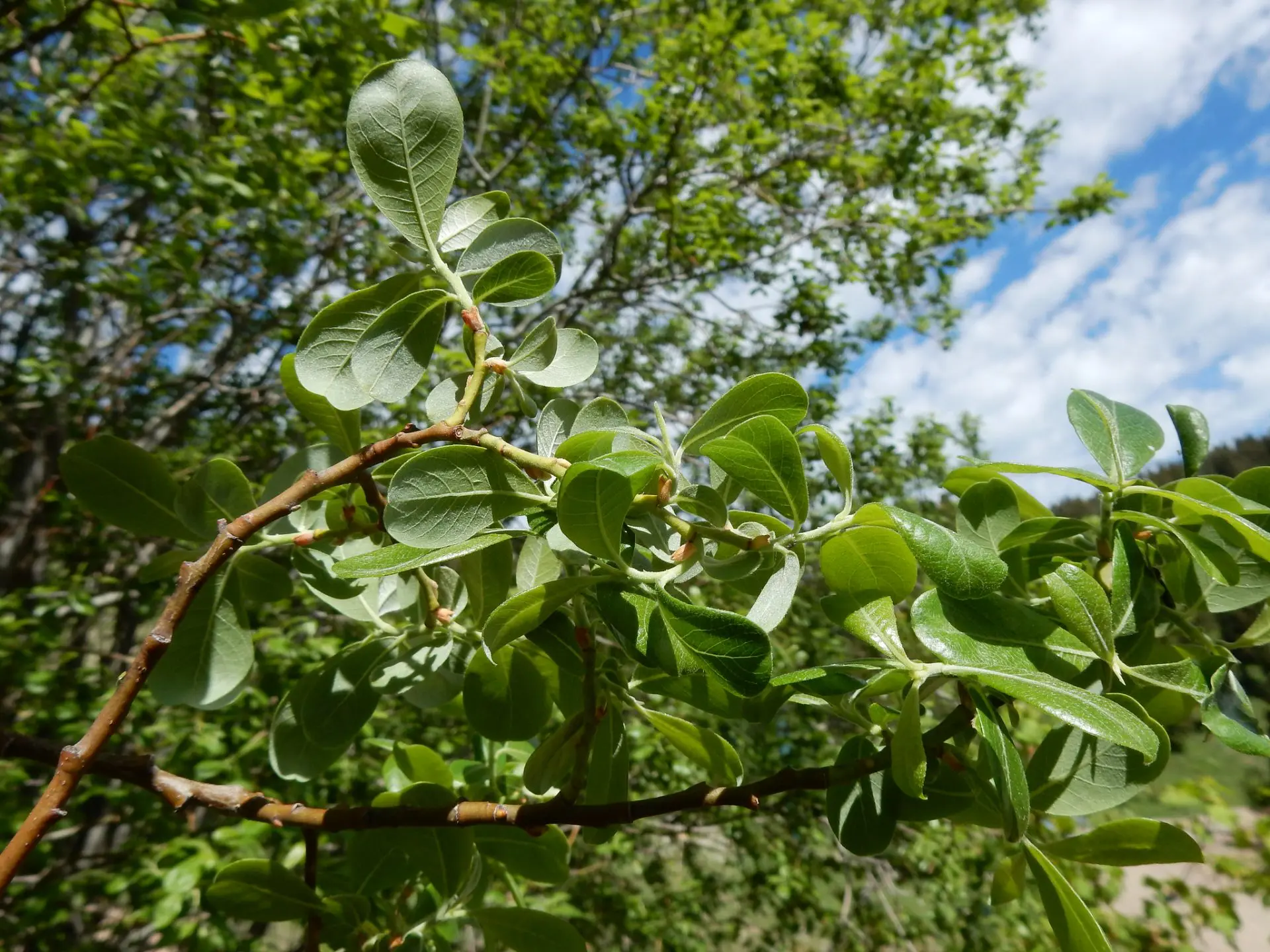
Matt Lavin/Flickr
Scouler’s willow produces the best wood for carving. This tree has many stems, which grow up to twenty-two feet or seven meters tall in dry areas and up to twenty meters in more favorable conditions.
These trees survive in arid conditions due to their fibrous, widespread, and deep roots. Scouler’s sapwood is almost white, but the heartwood is light brown with red tinges.
These trees’ twigs or branches are short and whitish green. Their leaves have an elliptic shape and grow up to thirteen centimeters long. You should note that these leaves don’t have sharp tips compared to the other willow species. However, their base is quite pointy.
The top sides of Scouler’s leaves are dark green and hairless, while the bottom part is whitish green and hairy. These leaf margins are also toothy and serrated, like most willows. Scouler’s flowers are white and pretty hairy.
Although this willow species is usually used to curb erosion, you could also use it as a hedge in your compound. Scouler’s willow is indigenous in the Black Hills of South Dakota, Central Manitoba, Coahuila, Washington, and Oregon.
7. Almond Willow
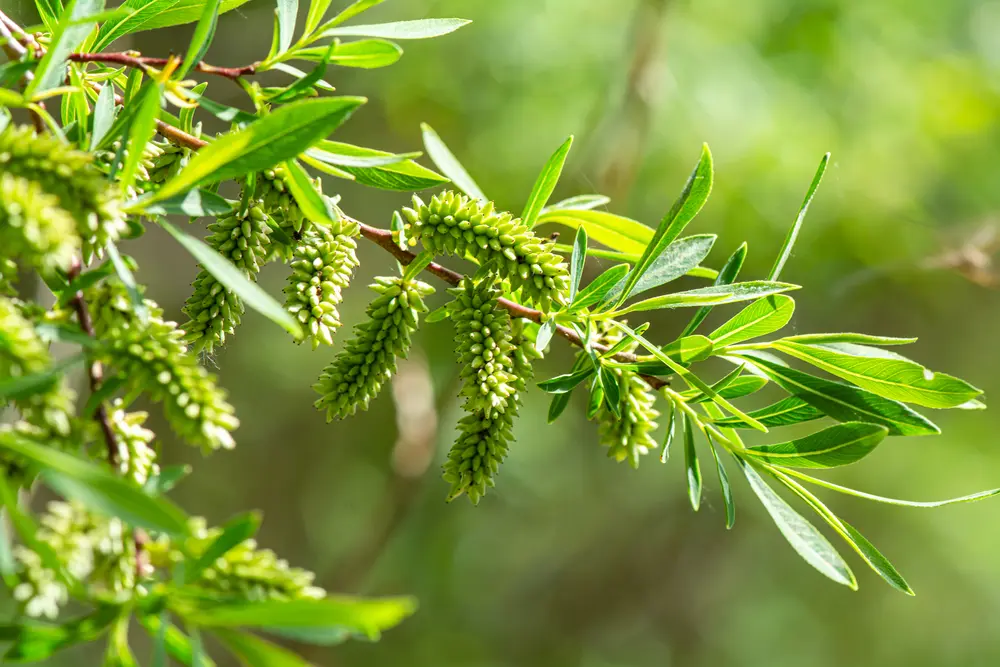
Burlacu Irina/Shutterstock
The almond willow is a shrubby deciduous tree that only grows up to thirty-three feet, or ten meters, high. This tree has multiple stems and an irregularly shaped crown.
Young almond willows have smooth brown barks, while mature ones are scaly and have orange-brown patches. Almond leaves have a lanceolate shape and serrated edges. They grow up to ten centimeters long and three centimeters wide.
The leaves are dull green on the top, while the bottom is grayish-green. This tree’s flowers pop up during spring. These flowers depend on insect pollination because the female and male flowers grow on separate trees.
Male flowers are usually eight centimeters, and female ones are four centimeters. Almonds’ male flowers have three stamens, while their other counterparts have two or five.
Almond willows have various uses. Honey industries use them in nectar production for bees. These shrubby plants also produce biofuel. You could also powder or grind the willow bark’s insides to make flour.
These trees are native to Central and Western Asia. Almond willows proliferate in full sun exposure and flourish in 4 to 9 USDA growing zones.
8. Crack Willow
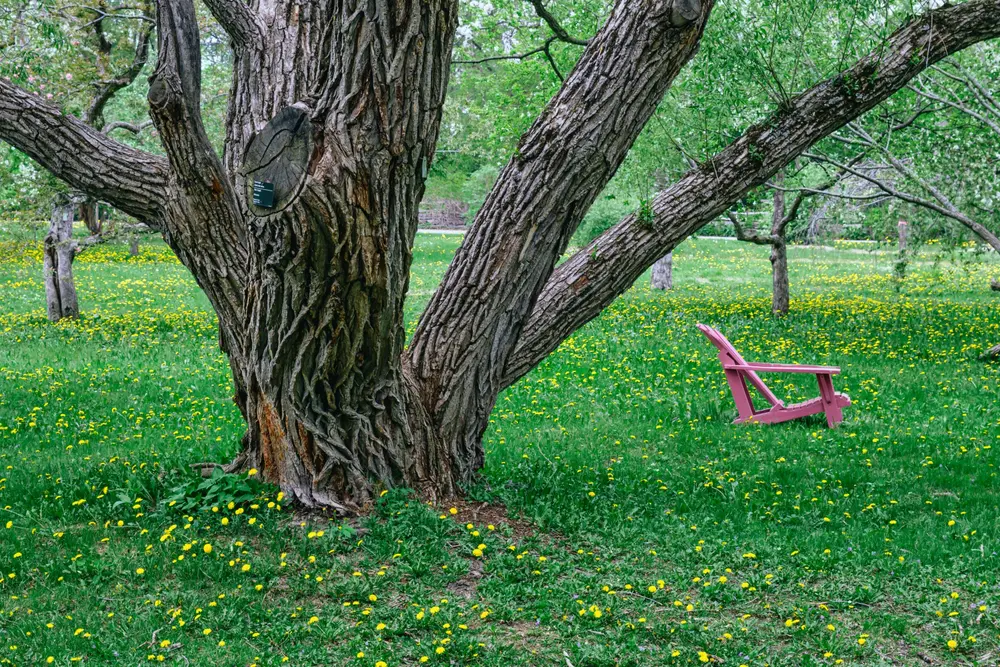
Marc Bruxelle/Shutterstock
Crack willows are medium-sized deciduous trees that grow up to sixty-six feet tall and have wide trunks of about one meter. These trees have multiple trunks or stems and disproportionate crowns.
Crack willows get their name from their branches’ sounds when they break. This tree has lanceolate leaves, which are light green and have serrated edges. The leaves grow up to fifteen centimeters long and three centimeters wide.
They may get a little hairy during the spring, but shed all the hair afterward. Crack flowers bloom during the spring and depend on insects for pollination as the male and female varieties grow on separate trees.
Both male and female flowers attain a length of about six centimeters. Male flowers are yellow, while their female counterparts are white. Crack fruits also appear during the spring and contain tiny fuzzy seeds.
These trees have slender, yellow-brown twigs and dark brown bark. Although you could easily confuse this tree with the white willow, crack willow leaves are shorter than white willows.
This tree is indigenous to Europe and Western Asia and typically grows along streams and lakes. Crack willows can grow in 4 to 9 USDA growing zones and flourish when exposed to full sun.
Considerations When Growing Willow Trees
Before you plant willow trees, you should first consider where you want to grow them, as some willow trees are invasive. Their roots may spread over your entire plant bed. To begin, dig a hole twice the size of the plant ball.
Then place the ball in the spot while spreading its roots. Afterward, fill the hole with soil halfway, add about two gallons of water, and cover. Although willow trees grow in most soil types, slightly acidic soils are the best.
You could add sulfur to your soil to make it acidic. Water the tree weekly within the first year of planting. After the first year, water the tree when necessary. Your willow tree needs watering if two inches of the topsoil feels dry.
Prune your willow trees so the branches stay up and have a single central trunk. Plant willow trees away from your house. These trees’ barks attract lots of pests, which may ruin your yard.
Frequently Asked Questions
Here are the most frequently asked questions regarding willow trees.
What is the difference between a willow and a weeping willow?
The weeping willow is one of the four hundred willow species.
What does willow symbolize?
Willow trees symbolize new life and fertility in most communities. This is because a cut branch can easily grow into a sapling and thrive.
Are willow trees invasive?
Willow trees are invasive as they can spread more than three times their size in your lawn. Their roots will also create bumps in your yard, making maintenance difficult.
Are willow trees poisonous?
Willow trees aren’t poisonous to humans. However, you may suffer some complications if you ingest them directly.
How much is a willow tree worth?
The value of willow trees varies due to their size and variety. Some willows cost as low as 10 USD, while others go for 800 USD.
So, What Are the Different Types of Willow Trees
The common types of willow trees are bebb willow, weeping willow, corkscrew willow, dappled willow, purple osier willow, Scouler’s willow, almond willow, and crack willow.
Planting these trees in your yard is beneficial, as they have several uses and can act as decorative pieces. Happy planting!

